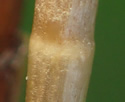Juncus torreyi (Torrey's Rush)
| Also known as: | |
|---|---|
| Genus: | Juncus |
| Family: | Juncaceae (Rush) |
| Life cycle: | perennial |
| Origin: | native |
| Habitat: | sun; moist to wet; pond edges, stream banks, marshes, wet ditches, swales |
| Fruiting season: | July - October |
| Plant height: | 12 to 40 inches |
| Wetland Indicator Status: | GP: FACW MW: FACW NCNE: FACW |
| MN county distribution (click map to enlarge): |  |
| National distribution (click map to enlarge): |  |
Pick an image for a larger view. See the glossary for icon descriptions.
Detailed Information
Flower: 


![[photo of flower heads]](/udata/r9ndp23q/se/juncus-torreyi-t.jpg) 1 to 23 flower heads in a tight cluster at the top of the stem, the short branches ascending to spreading, the lowest branch subtended by an erect to ascending, leaf-like bract that overtops the cluster, often significantly so. Each flower head is round, 1 to 1.5 cm in diameter, with 25 to 100 flowers. Flowers have 6 tepals (petals and similar sepals) in 2 layers, the outer tepals 4 to 6 mm long, the inner shorter, 3.4 to 4.6 mm long, all sharply pointed at the tip and green to straw-colored, sometimes reddish, drying to dark brown. Flowers have a 3-parted style and 6 stamens, the anthers (tips) about half as long as the filament (stalk).
1 to 23 flower heads in a tight cluster at the top of the stem, the short branches ascending to spreading, the lowest branch subtended by an erect to ascending, leaf-like bract that overtops the cluster, often significantly so. Each flower head is round, 1 to 1.5 cm in diameter, with 25 to 100 flowers. Flowers have 6 tepals (petals and similar sepals) in 2 layers, the outer tepals 4 to 6 mm long, the inner shorter, 3.4 to 4.6 mm long, all sharply pointed at the tip and green to straw-colored, sometimes reddish, drying to dark brown. Flowers have a 3-parted style and 6 stamens, the anthers (tips) about half as long as the filament (stalk).
Leaves and stems: 


![[photo of sheath auricle]](/udata/r9ndp23q/grass/juncus-torreyi_0905_160410-t.jpg) A flowering stem has 2 to 5 alternate leaves and 1 to 3 basal leaves. Leaves are 5 to 12 inches long, up to 5mm wide, round in cross-section, with cross partitions at regular intervals (may be easier felt than seen). Color is green to red. The sheath is open at the front. At the tip of the sheath is a pair of lobes (auricles) 1 to 4 mm long, with a rounded tip and a papery band around the edge. Stems are smooth, erect, and unbranched. Plants form loose colonies from spreading rhizomes with tubers at the nodes, from which new flowering stems arise.
A flowering stem has 2 to 5 alternate leaves and 1 to 3 basal leaves. Leaves are 5 to 12 inches long, up to 5mm wide, round in cross-section, with cross partitions at regular intervals (may be easier felt than seen). Color is green to red. The sheath is open at the front. At the tip of the sheath is a pair of lobes (auricles) 1 to 4 mm long, with a rounded tip and a papery band around the edge. Stems are smooth, erect, and unbranched. Plants form loose colonies from spreading rhizomes with tubers at the nodes, from which new flowering stems arise.
Fruit: 
![[photo of mature capsule and seed]](/udata/r9ndp23q/grass/juncus-torreyi-4-t.jpg) Fruit is a 3-sectioned capsule 4.3 to 5.7 mm long, as long as or slightly longer than the tepals, the tip with a long taper to a pointed tip, straw-colored to chestnut brown. Inside are numerous elliptic to egg-shaped seeds with an abrupt narrowing to a blunt tip at each end. Seeds are about .5 mm long, yellowish to brown with a textured surface.
Fruit is a 3-sectioned capsule 4.3 to 5.7 mm long, as long as or slightly longer than the tepals, the tip with a long taper to a pointed tip, straw-colored to chestnut brown. Inside are numerous elliptic to egg-shaped seeds with an abrupt narrowing to a blunt tip at each end. Seeds are about .5 mm long, yellowish to brown with a textured surface.
Notes:
Torrey's Rush is a common wetland species in Minnesota. The rounded heads can resemble 2 other Minnesota rushes: Knotted Rush (Juncus nodosus) and Canada Rush (Juncus canadensis), both of which have smaller (1cm or less diameter) and less densely flowered heads. J. nodosus is also a rather smaller plant, typically under 20 inches tall, with fewer than 30 flowers per head. J. canadensis has up to 50 heads in the cluster, 5 to 50 flowers per head, and the inner tepals are slightly longer than the outer, where J. torreyi inner tepals are shorter than the outer.
Native Plant Nurseries, Restoration and Landscaping Services ↓
More photos
 Torrey's Rush plants
Torrey's Rush plants Torrey's Rush plants
Torrey's Rush plants Torrey's Rush plants
Torrey's Rush plants septate leaf partition more easily seen when dry, felt when green
septate leaf partition more easily seen when dry, felt when green fruiting head
fruiting head comparison of Juncus nodosus, J. canadensis and J. torreyi
comparison of Juncus nodosus, J. canadensis and J. torreyi
Photos by K. Chayka taken in Anoka and Ramsey counties. Photos courtesy Peter M. Dziuk taken in Marshall County.Other photos courtesy Steve Eggers.
Comments
Have you seen this plant in Minnesota, or have any other comments about it?
on: 2018-06-30 08:36:13
These have the brown flower heads on them now and so are quite easy to identify. I was surprised that French had these beauties in there! These are in the marshy areas along the trail edge and further in
on: 2018-06-30 09:21:41
Cheryl, what you found was likely the more common Schoenoplectus pungens, three-square bulrush. Torrey's bulrush isn't known to be in Hennepin County - it would be a new county record if true.






